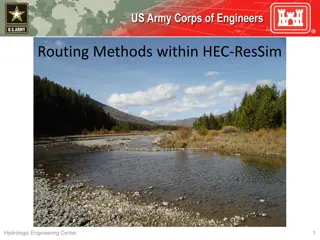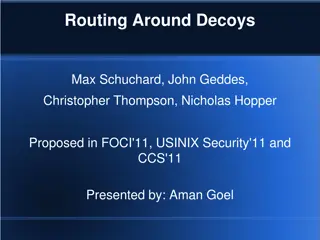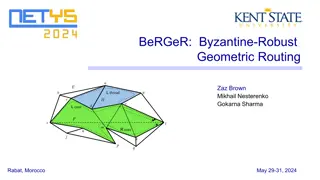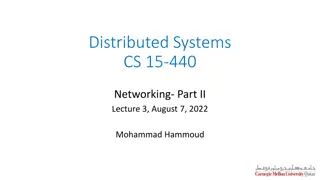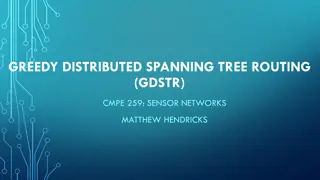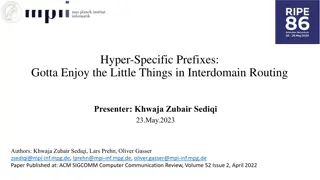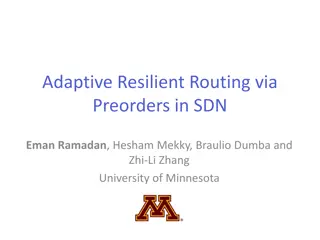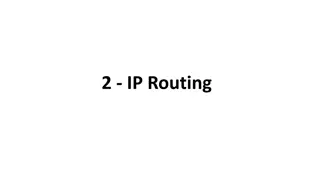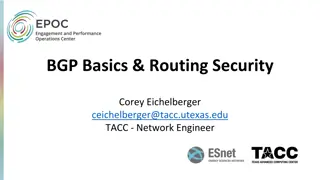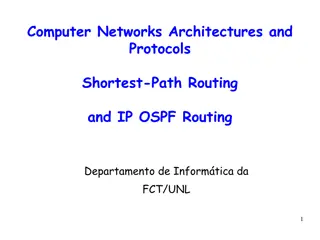
Compact Routing Schemes and Applications
Explore the world of compact routing schemes and their applications in network structures, from preprocessing phases to extreme solutions. Learn about the history, challenges, and solutions offered by these routing techniques for efficient data transfer across networks.
Download Presentation

Please find below an Image/Link to download the presentation.
The content on the website is provided AS IS for your information and personal use only. It may not be sold, licensed, or shared on other websites without obtaining consent from the author. If you encounter any issues during the download, it is possible that the publisher has removed the file from their server.
You are allowed to download the files provided on this website for personal or commercial use, subject to the condition that they are used lawfully. All files are the property of their respective owners.
The content on the website is provided AS IS for your information and personal use only. It may not be sold, licensed, or shared on other websites without obtaining consent from the author.
E N D
Presentation Transcript
Succinct Graph Structures and Their Applications Ulpana Summer 2024 Class 3: Routing Schemes
Compact Routing Schemes A distributed protocol to deliver packets from any node of a network to any other node. ?(?) Forward a message from source to destination through a chain of intermediate nodes ? ? ? Each node makes a decision on the next hop based on the header of the msg and its routing-table
Routing Schemes Preprocessing phase: computes for each vertex ? Label ?(?) (address of ?) Routing table ?(?) ?(?) ? Routing phase, for every vertex ?: Input: Header (? ? ), routing table ?(?) Output: Next-hop (port number of ?) Header: ?(?) ? ? Objective: small-space labels and routing tables small-stretch paths
Routing Schemes: Two Extreme Solutions Label ?(?) = ??(?) Routing table ?(?) Header: ?(?) Destination ?1 ?2 Next-Hop ?1 ?2 ? ?1 ?2?3 ?4 ?? ?3 Tables of linear size
Routing Schemes: Two Extreme Solutions ? Header (u v): [? = ?0,?1, ,? = ?] Headers of linear size Header: [? = ?0,?1, ,? = ?] Goal: Poly-log header size Sublinear routing tables Must resort to approx. distances ?
The Best One Can Hope For* *Under Girth Conjecture Routing Schemes define paths and distances between all pairs Last Class: Erdos girth conjecture implies (?1+1 ?) space for (2? 1) stretch For stretch 2? 1, there must be a vertex ? with ? ? = (?1/?)
History of Routing Schemes Stretch Space Labels ?(1) Total space ?(?1+1/?) ?(?2/3) Peleg, Upfal 89 (unweighted) ?(?) Cowen, 99 3 ?(?1/2) ?(?1/?) Eliam, Gavoille, Peleg 98 5 ?(?2) Awerbuch, Peleg 92 ?(??/?) Thorup-Zwick 01 ?? ? ?(??/?) Thorup-Zwick 01 + Handshaking* ?? ? *sourceand destination agree on ?(1) bits
Outline Routing schemes for trees with space ?(deg logn) Routing schemes for trees with space ?(1) Routing schemes for general graphs with: Space (routing tables): ?(n1/?) Stretch: 4? 3
Interval Routing [Santoro, Khatib 85] DFS numbering Label is a range of DFS numbers ? ? = ??? ? ,??? ? ? : last visited descendant of ? 1 ? Routing table ? ? = { ? ? ? ?(?)} 2 8 7 Example: 3 6 ? ? : 2,6 9 10 11 ? ? : { 1,11 , 3,5 ,[6,6]} 4 5
Interval Routing 1 ? ? = [3,5] ? ? = { 1,11 , 9,9 , 10,10 ,[11,11]} ? 1 = { 2,5 , 7,7 , 8,11 } 2 8 7 ? ? 2 = { 3,5 ,[6,6]} 3 6 ? Each ? ? requires ?(deg ? log n) bits 4 5 9 10 11
Improved Routing Schemes for Trees [TZ01] Labels of ?(log2?) bits Routing tables of ?(log?) bits Tool: Heavy Light Tree Decomposition (Sleator and Tarjan) Recursive partitioning of tree into a collection of vertex-disjoint paths
Heavy-Light Tree Decomposition Define the heavy child of node u to be the (unique) child of largest subtree. The remaining children are light ? Note: for every light-child ? of ? it holds: ? T w |T u |/2 ? An edge (?,?) is light (heavy) if ? is light (heavy)
Heavy-Light Tree Decomposition Thm 1: There exists an ?(?) time algorithm that computes a path ? ? whose removal breaks ? into vertex-disjoint sub-trees ?1, ,? s.t: ?? ? ? 2and ? is connected via an edge to each ?? ? Proof: simply go to heavy-child on each step ? The HL decomposition is given by applying recursivelyThm .1
Heavy-Light Tree Decomposition Observation 1: paths ?? = {?1, ,? } cover all heavy edges Observation 2: any path from root to node ? contains ?(log?) light edges Proof: the path can interacts with ?(log?) path in ??
Improved Routing Scheme for Trees Preprocessing algorithm: DFS numbering Heavy-light decomposition Label ? ? : 1. ?(log ?) light-edges on the path from root to ? 2. ???(?) ? Routing table ? ? : 1.[??? ? ,??? ? ] 2. Parent of ? 3. Heavy child of ?
Improved Routing Scheme for Trees Label ? ? :?(log ?) light-edges on the path to ?+ ???(?) Routing table ? ? : ??? ? ,??? ? ? , parent of ?, heavy child of ? Routing Alg. at node ? (target v): 1. If ? ? ? , forward to parent 2. If ?,? ?(?), forward to ? ? 3. Forward to heavy child ? Label space: ? log2 ? Table space: ?(log ?)
From Trees to General Graphs: Tree Covers Tree Covers: a family of trees T = { ?1, ,? } such that: For every ?,? there is a tree ?? ? containing low-stretch path between them. From routing on general graphs to routing on trees with stretch TZ DO implicitly defines a tree-cover with the following properties: Each vertex belongs to ?(?1/?) trees Every pair of vertices ?,? has a tree ?? such that ????,? (2? 1)??(?,?)
Short Recut of TZ Distance Oracles Preprocessing algorithm: ? = ?0 ?1 ?? 1 where ?? ?????? ?? 1 ,? 1/? Pivot ??? closest vertex to ? in ??, ? ?,? {0, ,? 1} Bunch ??? { ? ?? ??+1 ? ?,? < ?(?,??+1? )} ,? {0, ,? 2} ?? 1? = ?? 1 Store in hash-table distances between ? and every vertex in ? ? = ???(?) Query algorithm: Let ? be min value such that ?? ? ?(?). Last class: ???,?? ? + ???? ? ,? ?? ? ??(?,?)
Bunches A0= A1= A2= p2(v) v p1(v) ??? { ? ?? ??+1 ? ?,? < ?(?,??+1? )} *Slide taken from Uri Zwick presentation 19
Approximate Routing Schemes for General Graphs Labels of ?(? log2?) bits Tables of ?(??1/?log2?) bits Stretch 4? 3 Definition for vertex ?: ?? shortest-path tree rooted at ? Routing scheme for ??: L u,Tw and ?(?,??) for every ?
Approximate Routing Schemes for General Graphs Preprocessing algorithm: Compute the bunches and pivots of TZ oracles. For every node ?:?0? , ,?? 1(?), ?(?) ?? (?) Label ? ? = { L u,T?0? , ,L u,T?? 1? } Routing tables ? ? = ? ???(?,??) ? ?:?? ? ,?(?) Let ? be min value such that ?? ? ?(?) ?
? wants to send a message to ? Using ?(?) and ?(?) computes i = min ??? ?(?) ? = ?? (?) ? Forms an header: ? = (?? ? ,? ? ) ? Claim: For every ? ?(?,?,??), ? ? ? ? ?:?? ? ,?(?) Every intermediate ? compute next-hop based on ?(?,??) and ?(?,??) ?
Approximate Routing Schemes for General Graphs ?(? log2?) bits Label ? ? = { L u,T?0? , ,L u,T?? 1? } Routing ? ? = ? ???(?,??) ?(??1/?log2?) bits ?? (?) Stretch: ???,?? ? + ???? ? ,? ?? ? ??(?,?) ? ? ?
Lemma: If ??? ?(?) then ??? ? ? for every ? ?(?,?,??) Assume ? ? ?,?,??(the other case is solved similarly) Let ? be the largest index s.t ??? ?? ??+1 Note: ??? = ??(?) ? = ??(?) ? ??? ? ? ? ?,??? < ?(?,??+1? ) ? ?,??? = ? ?,? + ? ?,??? < ?(?,??+1? ) ? ? ? ?,??+1? ? ?,? + ?(?,??+1? ) ??? ?(?)

